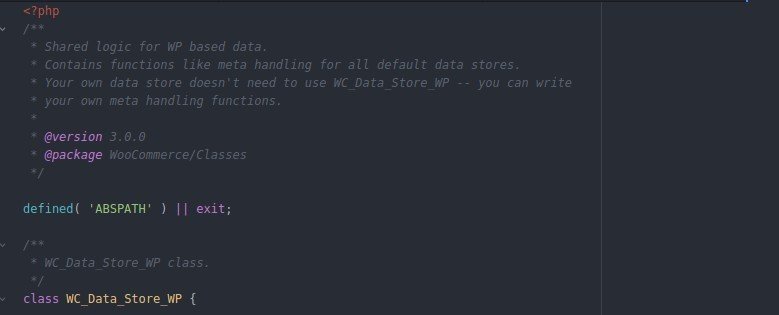Implementing Custom Data Stores
Overview
It’s no overstatement to say that the addition of the data store layer of abstraction in WooCommerce 3 opened up an entirely new world of possibilities. Whether your objective is customizing behavior, optimizing performance, or creating an entirely new sales proposition in WooCommerce, data store can provide an elegant way to accomplish the task.
This level of coding can be considered “heavy lifting” in any WP/WooCommerce group of developers. While the considerations are significant, you’ll see that the process is fairly straightforward, with several major players in the industry providing us with a template for success
Custom Data Stores: A Word of Caution
It is generally known: Historically, WooCommerce has not been highly performant software. Especially with larger stores with over 10k products/purchase orders
As a result of this, the innovative community of WordPress and WooCommerce developers is toiling away to solve this problem. The most notable efforts are Liquid Web’s flattened order table plugin and the custom product table plugin that have been developed by WooCommerce
The big players are working on developing solutions, and there’s a good chance that their solutions will end up in the Woo Core at some point in the future. So make sure you’re not creating extra work for yourself down the line by reinventing the wheel.
And with that…
Custom data stores:
Your key to doing whatever you want!
- All data stores are loaded by the WC_Data_Store:load method, which is run through two filters
- This means that every WC_Data class can be set up with your custom data store. So, not only can you customize the way data is stored in the database—you can set unique property and meta values, which will drive custom behavior–without the need to extend the WC_Data class itself!

Requirements
- In creating a custom data store the key requirement is to implement the WC_Object_Data_Store_Interface. Otherwise, WC_Data_Store will throw an error.There is an instanceof check in WC_Data_Store’s constructor
- There are also several ‘assistant’ interfaces, which are not mandatory (i.e. will not result in an error). However, they help ensure reliable behavior.
‘Assistant’ Interfaces
WC_Abstract_Order_Data_Store_Interface
WC_Customer_Data_Store_Interface
WC_Customer_Download_Data_Store_Interface
WC_Customer_Download_Log_Data_Store_Interface
WC_Object_Data_Store_Interface
WC_Order_Data_Store_Interface
WC_Order_Item_Data_Store_Interface
WC_Order_Item_Product_Data_Store_Interface
WC_Order_Item_Type_Data_Store_Interface
WC_Order_Refund_Data_Store_Interface
WC_Payment_Token_Data_Store_Interface
WC_Product_Data_Store_Interface
WC_Product_Variable_Data_Store_Interface
WC_Shipping_Zone_Data_Store_Interface
WC_Webhook_Data_Store_Interface

Building your custom data store class
- Ensure you are passing your data object by reference (ie &$data ). The data stores need to be able to directly modify the object it supports.
- You don’t have to completely start from scratch. It’s perfectly acceptable to
extend one of the existing datastores and override the behavior that is specific to your project.
- Consider the WC_Data_Store_WP class as a base, if other descendants won’t work.

Converting to the new data store
Once you’ve created your new custom data store class, and applied it using either the ‘woocommerce_data_stores’ or the ‘woocommerce_{$object_type}_data_store’ filter. You’ll likely need to convert existing data over. This is the most complex part of the task. We’ll use Liquid Web’s (LW) plugin as an example.
- You’ll need a method, for retrieving the data from the database using the old method. LW’s populate_order_from_post_meta is a good example
- Next, you’ll need to convert the data into the new format using your data object’s save() and/or update_post_meta() method. LW’s plugin achieves this in the populate_from_meta method on line 408.
- Finally, scrub the old data from your database (line 418)
Note: if your are planning on distributing your plugin, you need to include a user friendly method for both migrating to and from your custom data stores. If this is your situation LW’s WP-CLI methodology is a great methodology to examine.
Conclusion
Complex but powerful, custom data stores provides an extraordinary amount of flexibility in customizing WooCommerce.
While it is a bit daunting, you should now have a clear idea of the steps involved in creating a custom data store to support your project. If you need more specifics, the resources provided in the references section are excellent. and even includes an explainer from WooCommerce in their Wiki
Take a deep breath, create a backup, and test your mettle in unlocking the full potential of WooCommerce for your project.
This conclude the topic and the course! Remember this course is designed to be searchable, nimble, and is continuously updated, so keep this material in your back pocket and use it to breeze through your next WooCommerce project!
Knowledge Check
Quiz Summary
0 of 1 Questions completed
Questions:
Information
You have already completed the quiz before. Hence you can not start it again.
Quiz is loading…
You must sign in or sign up to start the quiz.
You must first complete the following:
Results
Results
0 of 1 Questions answered correctly
Your time:
Time has elapsed
You have reached 0 of 0 point(s), (0)
Earned Point(s): 0 of 0, (0)
0 Essay(s) Pending (Possible Point(s): 0)
Categories
- Not categorized 0%
- 1
- Current
- Review
- Answered
- Correct
- Incorrect
-
Question 1 of 1
1. Question
Custom Data Store Must… (select all that apply)
CorrectIncorrect
References
- GitHub – woocommerce/woocommerce-product-tables-feature-plugin: Implements new data-stores and moves product data into custom tables, with a new, normalized data structure
- GitHub – liquidweb/woocommerce-custom-orders-table: Store WooCommerce order data in a custom table for improved performance
- Data Stores · woocommerce/woocommerce Wiki · GitHub
- woocommerce/class-wc-data-store.php
- woocommerce/class-wc-data-store-wp.php
Keyboard shortcuts
Down arrow Next slide
Up arrow Previous slide
Color codes
Hover over text more additional info